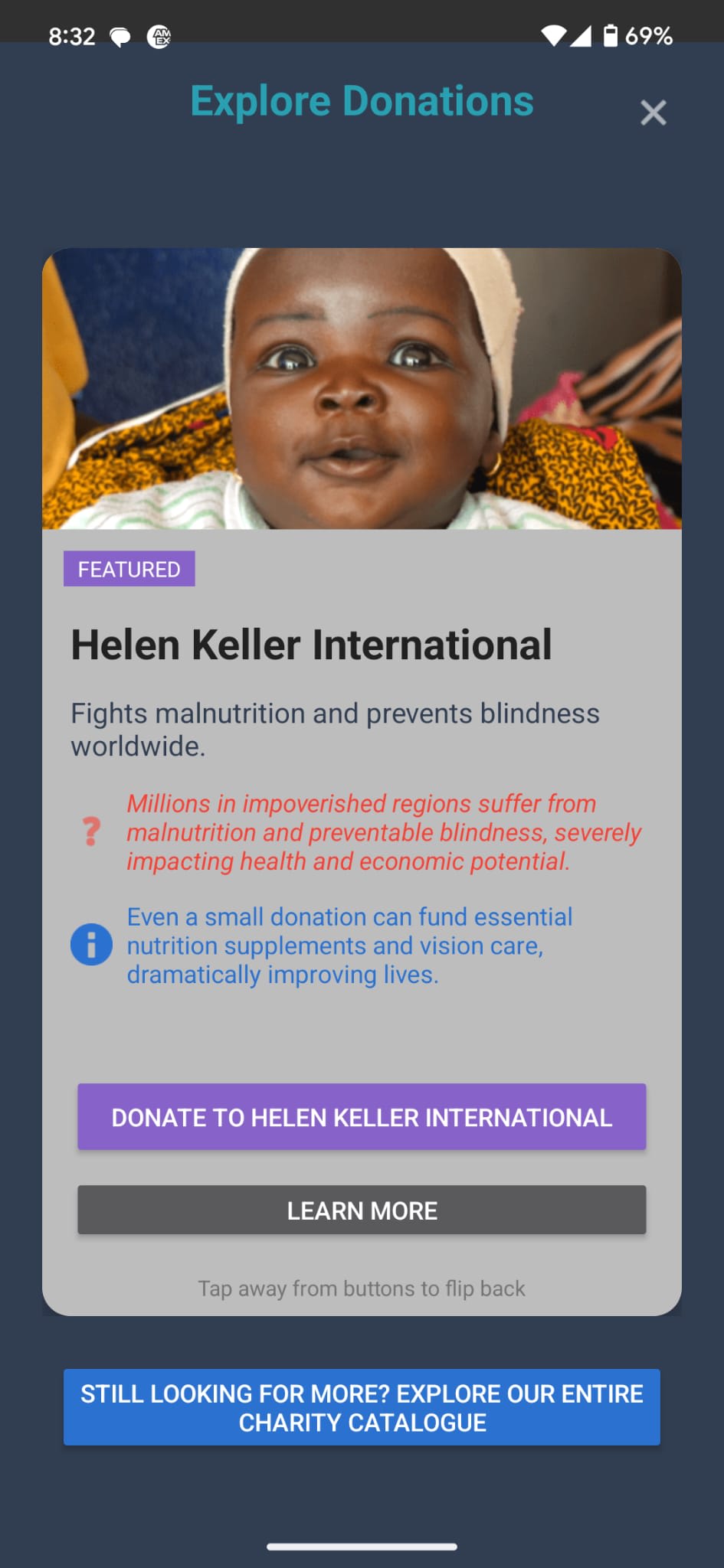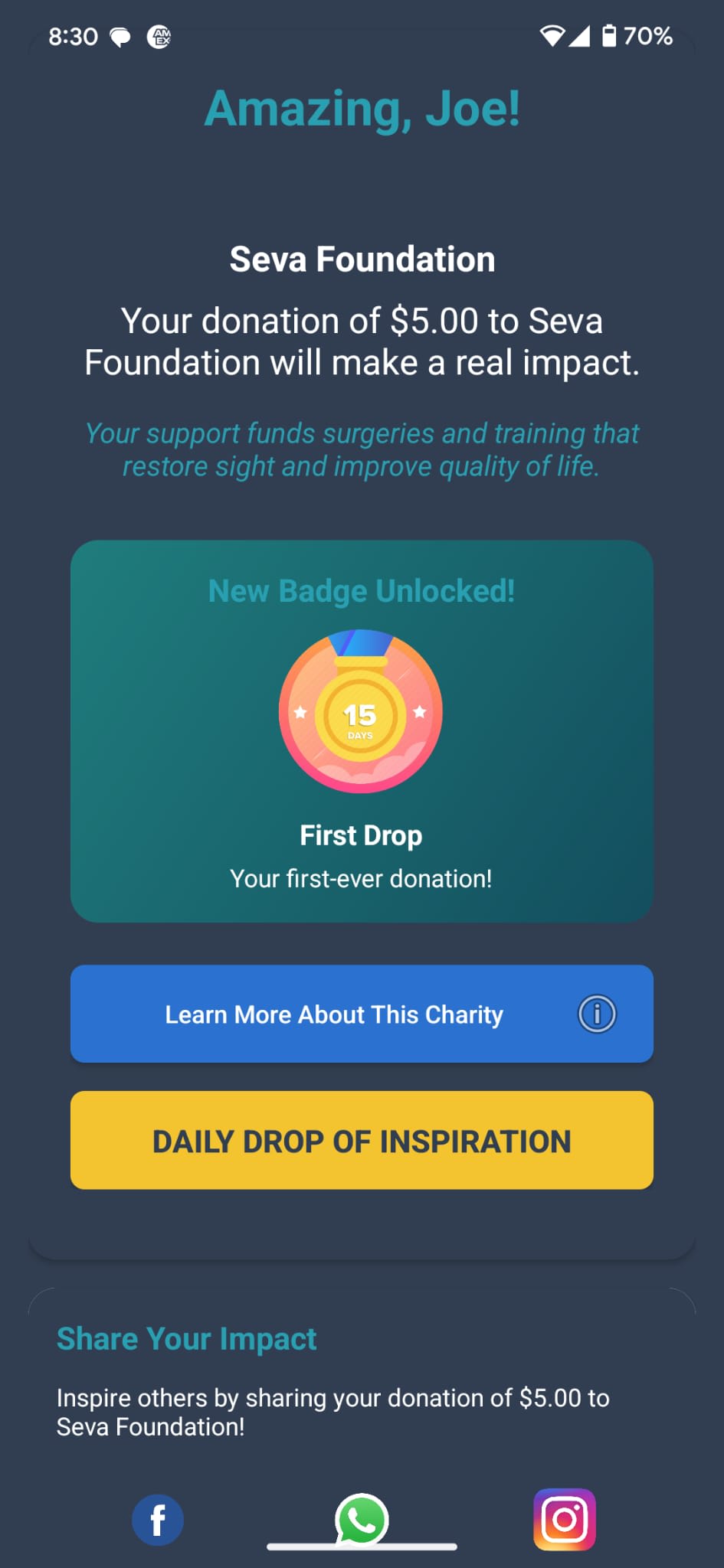Hi everyone,
About a month ago, I shared an initial idea for a “Dollar a Day” app—a platform that gamifies giving to help people build a daily habit of generosity. I’m excited to update you all on the progress my partner and I have made since then. We’ve rebranded the project as EveryDrop and have built a working prototype for Android using Kotlin and Firebase, complete with an integrated Stripe payment system. This post explains our progress to date and outlines the areas where we feel other members of this community could potentially help.
A Quick Walkthrough of EveryDrop
EveryDrop is designed to make daily giving as smooth, rewarding, and engaging as possible. Here’s a brief overview of the app’s flow based on our current prototype screenshots:
Splash Screen:
The app opens with a clean, visually appealing splash screen featuring the EveryDrop logo. This screen sets the tone with a minimalist design that reflects our commitment to simplicity and clarity.Home Page:
After the splash screen, users land on the home page where they are greeted with a “Make Today Count” button. This central call-to-action is enhanced by a subtle ripple animation and is complemented by inspirational messaging. Additionally, users see a dynamic community feed that highlights recent donations and community milestones, fostering a sense of collective impact.Charity Donation Card:
Tapping the main button directs users to a charity donation card. This card succinctly presents a selected charity along with its logo and a clear, quick donation option. The design encourages immediate action while maintaining an inviting look.Charity About Details:
For those who want to know more, tapping on a donation card brings up detailed “about” information. Here, users can learn about the charity’s mission, history, and operational model, helping them make informed giving decisions.Charity Impact Details:
Next, users can access an impact details screen that translates their donation into tangible outcomes. This page includes data points, testimonials, or visual cues that illustrate exactly how every dollar makes a difference, reinforcing the value of their generosity.Celebration Page:
Finally, the celebration page celebrates the user’s donation. With personalized messages, celebratory animations (like confetti bursts), and the potential display of an unlocked badge, this screen not only acknowledges the contribution but also encourages ongoing engagement by rewarding consistent giving.
Where We Need Your Help
While we’re excited about the progress we’ve made, there are several key areas where we could really use additional support - I'm hoping this post might allow us to access a wider network of talented indivdiuals who can contribute in the following ways:
- App Development:
- Enhancing the Android codebase and transitioning to Flutter to bring iOS support.
- Refining the user experience (UI/UX) and streamlining data management on our backend (Firestore).
- Brand Image & Graphic Design:
- Creating a consistent and engaging brand identity across all platforms—from our app interface and marketing materials to onboarding experiences.
- Designing user icons/avatars, custom badges, and a polished charity donation card.
- Considering an in-app anthropomorphized guide (a character akin to Duolingo’s Duo) to help users navigate the app.
- Marketing, Outreach & Community Building:
- Developing a comprehensive launch strategy that builds early social proof.
- Ideas include a dedicated webpage to explain the concept, a waitlist for an invitation-only beta, and early incentive packages (e.g., unique badges for early streaks, friend-invite rewards, or branded swag for early donors).
- Fundraising & Partnership Development:
- Although my partner and I have been self-funding the early development so far, we’re aware that scaling EveryDrop will require more support.
- We’re in the process of setting up a UK charity to help minimize bank fees and transfer costs, but we still need to secure independent funding to cover these operational costs.
- Our goal is to ensure that 100% of every donated dollar reaches the chosen charities by covering transaction fees through separate fundraising efforts.
- Strategic Advisory and Board Level Support
- My partner and I have a background in non-profit and business management but this is the first mobile app either of us have engaged with. We would welcome strategic advisors that inform and influence our approach including but not limited to:
- Decision design and nudge theory to encourage pro-social spending and reduce friction
- App design and gamification strategy to maximize positive emotion feedback to giving through the app interface
- Charity selection and recruitment
Fundraising strategy and corporate partnership outreach
- My partner and I have a background in non-profit and business management but this is the first mobile app either of us have engaged with. We would welcome strategic advisors that inform and influence our approach including but not limited to:
I’d love to hear your feedback, ideas, and any interest in collaborating further. Thank you for being a part of this journey to make generosity a daily habit!
Big thank you to @Matt Coleman🔹 and @Lucas Moore for their support so far










App product guy and mobile game designer (in a past life) here.
Suggestion would be to test and much as you possibly can quickly and cheaply with a bare bones MVP / prototype before you commit lots of time/money on charity setup, full app development, graphics/branding.
Most app concepts and UX's just don't resonate with users, find out if it does first before going further, and iterate as needed.
There's lots of good advice out there on how to do customer development, testing. I'd go both qualitative (blind play test, focus groups etc) and quantitative (embed analytics, see where people drop etc)
All the best with it!
Maybe dumb-question: Is there some way to do this through GWWC? If it used their donation platform/ was incubated legally by them maybe you could avoid this?